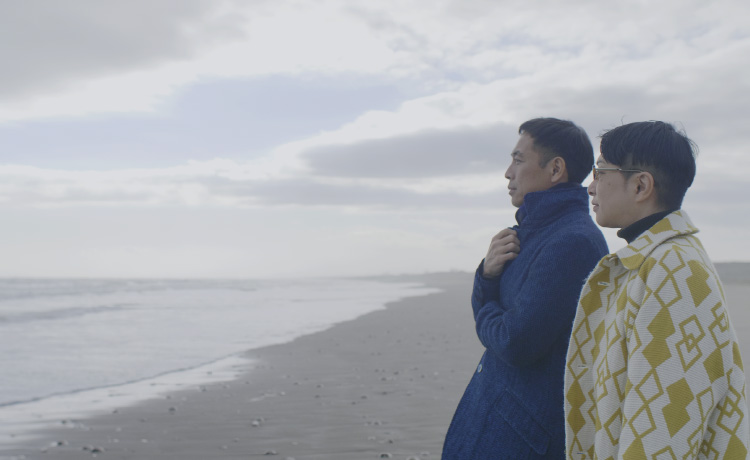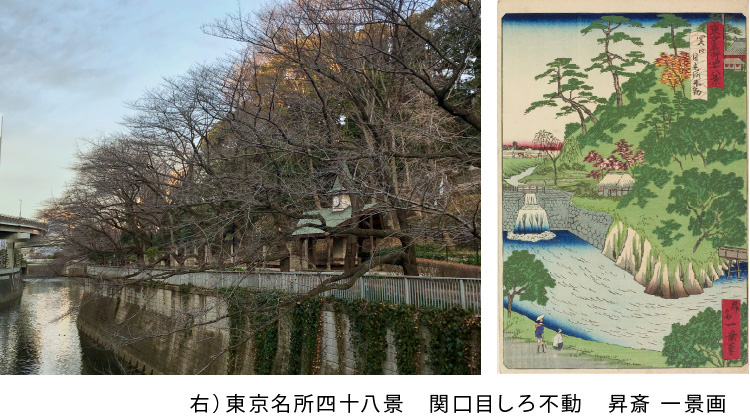



This edition features notable places near the new matohu shop and atelier as well as artisans who help make our collections possible.


Edo (the old name for Tokyo) was built on land reclaimed from the ocean, and securing fresh drinking water was a problem. The Kanda River was one source of drinking water, and the Oarai Weir is where the river diverges to flow downstream to Edo. It used to be a popular area for recreation, with pleasure boats plying its waters. Now only traces of this past remain, but in spring cherry trees in full bloom turn the promenade that follows the river a sea of pink.

The famed haiku poet Matsuo Basho came to Edo in his youth when he still called himself Tosei, and is said to have worked part-time at the Oarai Weir's guard house. A beautiful garden and hermitage still stand on that location. As we approached the garden's pond, we heard the sound of a frog jumping in the water just like in Matsuo Basho's famous haiku. (Really!)

A natural indigo dyeing atelier operates in Ome City, situated an hour northwest of central Tokyo. Aizome (Japanese indigo dyeing) used to be a thriving industry in Ome City, where striped cloth called Ome-jima was produced. Kosoen uses sukumo (concentrated indigo) made by Osamu Nii in Tokushima to create fermented indigo dye with oak-ash lye in a process unchanged from the Edo Period (1603–1868). Watching the artisans of all ages briskly go about their work was energizing.

Meriyasu, meaning knitted fabric, is a word derived from the Spanish or the Portuguese word for socks, which was introduced in the Nanban trade period of the 16th century. Purveyors of stretchy, machine-knitted meriyasu fabric are concentrated in the Ryogoku neighborhood of Tokyo, among them Kawabe Meriyasu, which has been in business for over 100 years. We fell in love with Kawabe's finely knitted, soft meriyasu fabrics and include them in our collection each season.

Kujukuri Beach is near the Chiba factory of Kawabe Meriyasu. The vast Pacific Ocean and sandy beach unfold as far as the eye can see. Kujuku means 99, and ri is a length of measurement originally from China that has long been used in Japan, with one ri equaling approximately 3.9 kilometers. The beach is some 66-kilometer long, meaning that in reality its length is closer to 17 ri. The day we visited, the ocean was churning with winter winds and high waves, and we watched a lone surfer with bated breath.

If you come to Hachioji City, you absolutely must try the local version of ramen! Hachioji ramen features a deeply flavorful soy sauce broth and toppings of diced raw onion and chashu pork. It's simple, but the crisp bite of the onion and the melt-in-your-mouth tenderness of the chashu will leave you craving another bowl!

Hachioji City used to be a center of textile manufacturing, and Miyashin was a weaving company with particular skill and creativity. The fabrics made by its president, Eiji Miyamoto, were seen on the runways during Paris Fashion Week and are in the permanent collections of famous museums overseas. In 2013 its facilities became part of Bunka Gakuen University's educational and R&D facilities. We have used their fabrics since the first matohu collection, and continue to work with them on new fabric development.
職種:店舗販売 / 営業 / 生産管理 / パタンナー / デザイナー
正社員登用、給与は経験により相談。月20万円以上。
年齢性別不問。
厚生年金、健康保険、雇用保険等完備。交通費支給、賞与。
ご希望の方は、メールにて履歴書と職務経歴書をお送り下さい。
通過者のみ面接の返信をいたします。なお募集の職種は時期によって異なる場合があるのでお問い合わせください。
*学生のインターンは随時可能ですので、希望者は面接いたします。
送信先メールアドレス:matohu@lewsten.com
◇ matohuの理念
「日本の美意識が通底する新しい服の創造」をコンセプトに文化や歴史を大切にしながら、現代人の心に響く魅力ある「デザイン」を生み出すこと。それを深い「言葉」で表現し、共感者の輪を拡げて行く「場」を作って行くこと。
この3つを通して、多様で心豊かな世界をともに作り上げることがmatohuのプロジェクトであり、理念です。
◇ 仕事のやりがいと人間的成長
まかされた仕事を自分の創意で工夫していける環境です。1Fはショップ、2Fはアトリエになっており、デザイナーと直接話しながらアイデアを実現していけます。また文化、歴史など幅広い知識を学ぶ機会も多く大人の教養と礼儀が身につき、人間的にも成長できます。
人の心に彩りを添えるデザインを生活のなかに!を合い言葉にこれから世界に向けて発信するmatohuのスタッフを募集します。